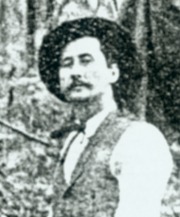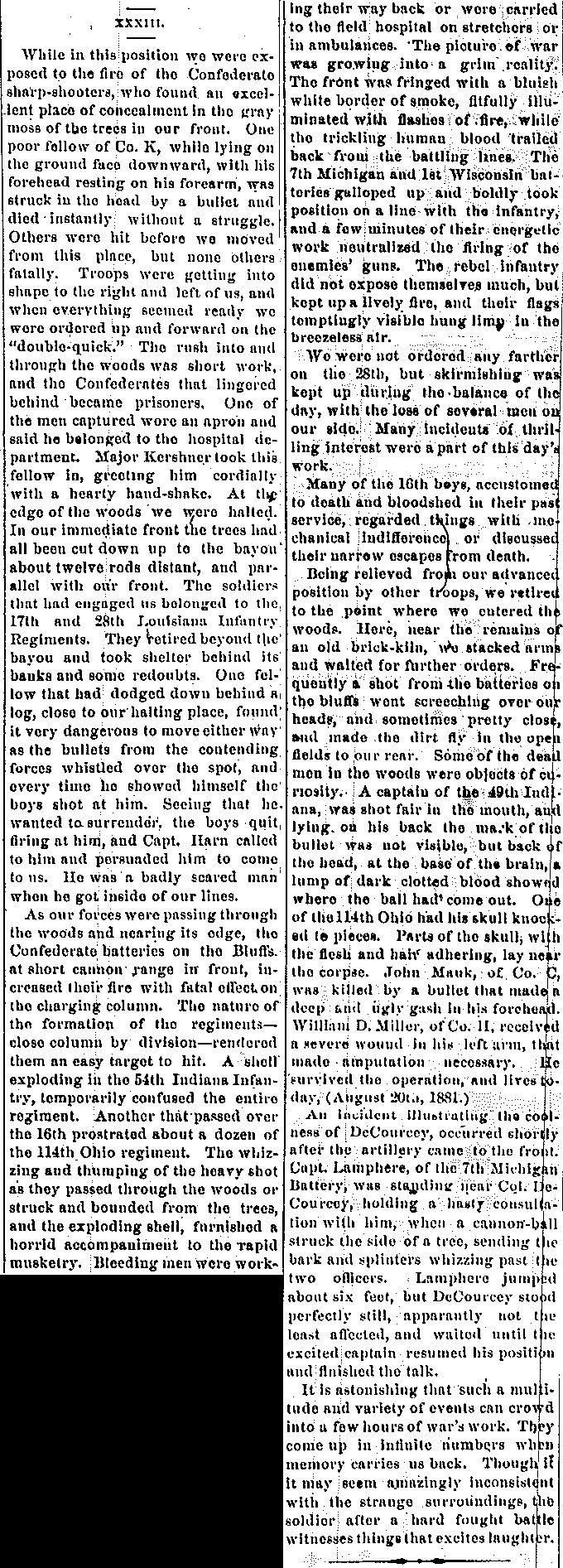| Camp & Field Page 53 | Camp & Field Index Page | 16th OVI Home Page | Camp & Field Page 54 |
The Camp & FieldArticles by Theodore Wolbach |
 Cpl. Theodore D. Wolbach |
The following image is taken from a book titled "Mortality and Statistics of the Census of 1850" in which it is believed retired Captain Rezin H. Vorhes, Company H, pasted over the pages a series of articles written by Cpl. Theodore D. Wolbach, Company E, titled "Camp and Field" and published, by chapter, in the Holmes County (Ohio) Republican newspaper from February 24, 1881 to August 17, 1882. The articles tell the story, in great detail and color, of the 16th OVI, from the inception of the 3-year regiment in October, 1861, through all its camps, battles and marches until it was disbanded on October 31, 1864. The articles pasted in the Vorhes book cover the first 35 chapters, published through October 20, 1881. All the remaining chapters were recently found in a Holmes County library by researcher Rob Garber who obtained copies, performed the transcriptions and provided to this website and which are also presented here, complete work by Theodore Wolbach.
Throughout these articles click on the underlined white text for additional details.
The webauthor thanks 16th Ohio descendant Rob Garber for his excellent research on the Camp And Field articles and for performing the tedious digital transcription of those articles found on each page. The transcriptions were made to reflect the original articles verbatim, misspellings and all. Rob is the 3rd great nephew of Capt. William Buchanan, Company F, 16th Ohio, who served in the 90-day regiment as a private, re-enlisting in the three year regiment, and eventually making the rank of Captain of Company F. Thanks Rob!
Page 53B - Chapter 33 - December, 1862
 |
Published in Holmes County Republican XXXIII. While in this position we were exposed to the fire of the Confederate sharp-shooters, who found an excellent place of concealment in the gray moss of the trees in our front. One poor fellow of Co. K, while lying on the ground face downward, with his forehead resting on his forearm, was struck in the head by a bullet and died instantly without a struggle. Others were hit before we moved from this place, but none others fatally. Troops were getting into shape to the right and left of us, and when everything seemed ready we were ordered up and forward on the As our forces were passing through the woods and nearing its edge, the Confederate batteries on the Bluffs, at short cannon range in front, increased their fire with fatal effect on the charging column. The nature of the formation of the regiments--close column by division--rendered them an easy target to hit. A shell exploding in the 54th Indiana Infantry, temporarily confused the entire regiment. Another that passed over the 16th prostrated about a dozen of the 114th Ohio regiment. The whizzing and thumping of the heavy shot as they passed through the woods or struck and bounded from the trees, and the exploding shell, furnished a horrid accompaniment to the rapid musketry. Bleeding men were work- |
working their way back or were carried to the field hospital on stretchers or in ambulances. The picture of war was growing into a grim reality. The front was fringed with a bluish white border of smoke, fitfully illuminated with flashes of fire, while the trickling human blood trailed back from the battling lines. The 7th Michigan and 1st Wisconsin batteries galloped up and boldly took position on a line with the infantry, and a few minutes of their energetic work neutralized the firing of the enemies' guns. The rebel infantry did not expose themselves much, but kept up a lively fire, and their flags temptingly visible hung limp in the breezeless air. We were not ordered any farther on the 28th, but skirmishing was kept up during the balance of the day, with the loss of several men on our side. Many incidents of thrilling interest were a part of this day's work. Many of the 16th boys, accustomed to death and bloodshed in their past service, regarded things with mechanical indifference, or discussed their narrow escapes from death. Being relieved from our advanced position by other troops, we retired to the point where we entered the woods. Here, near the remains of an old brick-kiln, we stacked arms and waited for further orders. Frequently a shot from the batteries on the bluffs went screeching over our heads, and sometimes pretty close, and made the dirt fly in the open fields to our rear. Some of the dead men in the woods were objects of curiosity. A captain of the 49th Indiana, was shot fair in the mouth, and lying on his back the mark of the bullet was not visible, but back of the head, at the base of the brain, a lump of dark clotted blood showed where the ball had come out. One of the 114th Ohio had his skull knocked to pieces. Parts of the skull, with the flesh and hair adhering, lay near the corpse. John Mauk [Marks], of Co. C, was killed by a bullet that made a deep and ugly gash in his forehead. William D. Miller, of Co. H, received a severe wound in his left arm, that made amputation necessary. He survived the operation, and lives to-day, (August 20th, 1881.) An incident illustrating the coolness of DeCourcey occurred shortly after the artillery came to the front. Capt. Lamphere, of the 7th Michigan Battery, was standing near Col. DeCourcey, holding a hasty consultation with him, when a cannon-ball struck the side of a tree, sending the bark and splinters whizzing past the two officers. Lamphere jumped about six feet, but DeCourcey stood perfectly still, apparently not the least affected, and waited until the excited captain resumed his position and finished the talk. It is astonishing that such a multitude and variety of events can crowd into a few hours of war's work. They come up in infinite numbers when memory carries us back. Though it may seem amazingly inconsistent with the strange surroundings, the soldier after a hard fought battle witnesses things that excites laughter. |
| Camp & Field Page 53 | Camp & Field Index Page | 16th OVI Home Page | Camp & Field Page 54 |